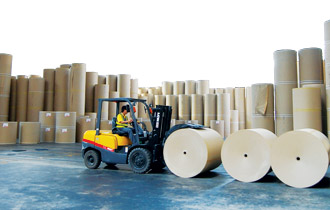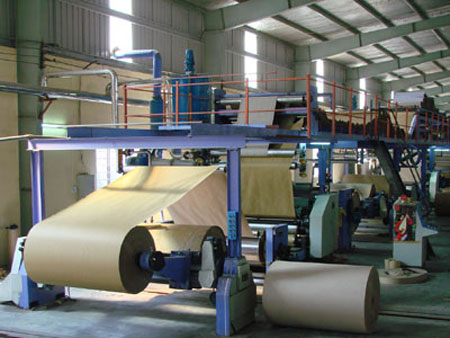Paper chase
Market News
Even though the market is mature in some areas, the pulp and paper business in Southeast Asia remains attractive with a substantial demand growth, and that has encouraged the entry of foreign manufacturers to compete with regional players.
Demand for pulp and paper products has been rising by 5% on average every year in Asean, helped by closer regional economic integration, large domestic markets and rising personal income, according to the Thai Pulp and Paper Industries Association (TPPIA).
As well, Thailand's "Kitchen of the World" strategy has spurred demand for food packaging, while the Philippines and Indonesia have embarked on similar promotional programmes. Tourism and retail sectors that have begun to open up in countries like Vietnam have also created market opportunities for paper and packaging products.
"The annual growth of 5% is impressive at a time when global GDP is expanding by around 2% and some sectors are experiencing a contraction," association president Marty Lin Mahaplerkpong told Asia Focus.
In Thailand, 4.7 million tonnes of paper are consumed every year while supply is between 4.5 million and 4.6 million, with 450,000 tonnes of new capacity in the pipeline. Myanmar, on the other hand, relies heavily on imports to serve domestic demand of 260,000 tonnes as supply is less than 70,000 tonnes.
In Vietnam, domestic production of 1.9 million tonnes is being expanded to 3 million, close to the fast-rising demand that has reached 3.15 million. The Philippines is also a net importer with domestic demand of 1.8 million tonnes, twice the supply of 900,000. Another 140,000 tonnes of capacity is scheduled to come onstream in 2018.
Indonesia has around 10 million tonnes of capacity against demand of 7 million. Malaysia has 3.1 million tonnes of demand against a supply of 1.8 million.
All told, Asean has a shortage of around one million tonnes of paper, but expansion in Vietnam and Thailand should lead to a demand-supply balance by 2018-19. On the pulp side there is a surplus of 1.8 million tonnes with no expansion planned at the moment.

Market opportunities remain strong for paper packaging products as sectors including tourism and retail gain momentum across the region.
"Most of the expansions are being carried out by local Asean companies except for Vietnam where the increase will also come from Chinese paper mill investors," said Mr Marty, the former chairman of the Federation of Asean Pulp and Paper Industries (FAPPI).
Meanwhile, the overall composition of the industry is changing. Writing and printing paper is experiencing a contraction because of shrinking demand for newspapers and magazines, but sectors such as packaging, hygiene and tissues continue to expand and propel overall industry growth.
With domestic consumption of 10 million tonnes, Indonesia is the largest pulp and paper producer in Asean but its capacity is mainly in pulp. Thailand ranks second in Asean and seventh in Asia where the top players include China, India, Pakistan, Japan and Korea. Thailand, however, is Asean's largest packaging paper manufacturer with capacity of 3.5 million tonnes, followed by Indonesia at slightly more than 2 million.
Half of the world's capacity is now in Asia as investments have been shifted from the US and Europe. Chinese operators began entering Southeast Asia a few years ago. One of their projects in Vietnam will be completed this year, and another in 2017.
In Thailand, the Board of Investment (BoI) no longer grants incentives to conventional paper projects. However, it will support investments in high-value paper products, packaging and hygienic packaging. As a result, major paper producers are looking to invest abroad, added Mr Marty


MIXED PICTURE
In Asean, Vietnam has high potential thanks partly to its competitive labour market, according to the US-based consulting and information service firm Fisher International.
"Southeast Asia is a mature market but some parts such as Vietnam are growing while Malaysia and Indonesia are flat," general manager Stanley Okoro told Asia Focus.
"Vietnam's labour market really good and the cost is cheaper than China. Besides, the Vietnamese government has identified strategic growth sectors including paper, and it has provided policies to support it including environmental policies that are business-friendly."
China, on the other hand, has embarked on a major drive to reduce pollution, with restrictions on water usage and tightened environmental regulations for some industries including paper mills.
"China has been a closed market and now it's getting used to extra competition as production costs have been surging including labour. That has impacts on production," said Mr Okoro.
"They are not low-cost producers anymore. Imports are also growing so the competitive landscape has changed."
Chinese players are coming to Asean where the population of 620 million makes the region attractive for the paper industry, he noted.
India is a different story. Despite its vast domestic market, complicated regulations have lessened India's potential in the pulp and paper business.
"The Indian market in general is a sleeping giant. It has been a surprise that we have not seen significantly more growth out of India which has a billion-plus people," said Mr Okoro.
"The Indian regulatory environment makes it difficult to grow the industry. They make it difficult for foreign investors to come in. The government tries to protect local producers and makes it hard to buy an Indian company without having a local partner."
Consequently, paper producers in India are mainly small even though the market is big. In some segments that should be doing well, such as tissue paper, the growth is "quite disappointing", he said.
India, he says, should open up and streamline its rules to make it easier to challenge inefficient local players. In the end, consumers would benefit as competition grows."
While individual markets have different characteristics, the pulp and paper industry in Asia as a whole is expected to undergo consolidation. The trend is clearest in North America, while Europe is embarking on similar changes. In Brazil and elsewhere in Latin America, some consolidation has taken place and more is coming, especially in the fibre segment.
In Asia, consolidation will be significant in China as the market slows, overcapacity starts to take its toll and big polluters that can't comply with new rules are shut down.
"If you've been to Shanghai or Beijing lately you can't breathe. The government has realised that if it doesn't act, 10 years from now medical bills will be enormous because everybody will get sick," said Mr Okoro.
"So the government will take steps to protect the citizens and that will affect what the industry does. That could lead to a significant amount of consolidation in China."
In Asean, leading producers in Thailand and Indonesia will prevail and most will operate across borders.
"You can see some minor consolidation in Asean with industry powerhouses such as SCG (Siam Cement Group of Thailand) buying some of the local producers in other Asean countries," said Mr Okoro.
But the trend will not be dramatic because industry fragmentation is not significant compared with China or as it used to be in North America and Europe, he added.

SUSTAINABILITY CHALLENGE
As the paper industry in Asean continues to thrive, it faces some tough sustainability issues.
Mr Marty of the TPPIA says the industry has been under pressure to cut energy and water consumption as part of the global effort to curb the impact of climate change.
Paper producers in Asean rely heavily on energy from coal-fired plants, given abundant coal supplies available at low prices.
"There is no argument that the pulp and paper business is among the most energy-intensive sectors in the world. We are trying to cope with our carbon footprint which is quite tough," he told a recent seminar at the Asian Paper Bangkok Symposium.
The carbon footprint for paper extends from the forest and raw material harvesting to manufacturing and garbage landfills.
"We are moving toward renewable energies including affordable clean coal," he noted. Producers have also tried to improve energy efficiency by terminating outdated boiler plants. Asean energy ministers have agreed to cut 20% of all industrial carbon emission by 2025, so improving efficiency has taken on some urgency.
As well, manufacturers are aiming for more recycled content. Using virgin fibre involves more greenhouse gases and toxic emissions, encourages unsustainable logging and degrades forest areas.
The industry projects that by 2020, for every 500,000 tonnes of paper produced, 70% will be from recycled paper with the balance virgin fibres, versus 47:53 in 2010. This can be done by utilising advanced paper making technology and sourcing fibres from credibly certified natural forests and plantations.
Companies are also trying to reduce water consumption per tonne of paper produced and to treat the effluent according to higher standards. A closed manufacturing process can help in this regard.
At Tetra Pak, the world's leading food processing and packaging company, innovation is a key to addressing the challenges faced by the industry.
"Innovation is the key to adapting to the demographic, economic and environmental shifts that are driving change in the packaging and processing industry," said Jeff Fielkow, vice-president for the environment for Tetra Pak Asia.
Among its innovations is a 100% renewable carton produced solely from paperboard and plastic derived from plants, which has the same performance and functionality as conventional packaging.
"The packaging industry continues to make great strides in becoming more sustainable and this requires commitment from all parties to protect forests and resources," he told Asia Focus.
Tetra Pak, for instance, has set a goal of achieving a 40% global recycling rate by 2020. The company has also committed to increasing the use of electricity from renewable resources across all global operations to 100% in 2030 from 20% now.
# TAG
0 bình luận
Viết bình luận
tin liên quan
Tin mới nhất
THÔNG BÁO KẾT QUẢ CHƯƠNG TRÌNH "KHAI XUÂN PHÚ QUÝ – LÌ XÌ HẾT Ý 2024"
16-03-2024 | Tin Tức Công Ty
876 Lượt xem
0 bình luận
THÔNG BÁO VỀ VIỆC THAY ĐỔI ĐỊA CHỈ CỦA VĂN PHÒNG ĐẠI DIỆN TẠI TP. HỒ CHÍ MINH
29-12-2023 | Tin Tức Công Ty
1845 Lượt xem
0 bình luận
tin nổi bật
THÔNG BÁO KẾT QUẢ CHƯƠNG TRÌNH "KHAI XUÂN PHÚ QUÝ – LÌ XÌ HẾT Ý 2024"
16-03-2024 | Tin Tức Công Ty
876 Lượt xem
0 bình luận
Thông báo kết quả trúng thưởng chương trình “Hái Lộc Đầu Xuân Năm 2022”
10-03-2022 | Tin Tức Công Ty
2970 Lượt xem
0 bình luận
tin được xem nhiều nhất
Nguyên liệu ngành giấy: Thiếu nhưng vẫn lãng phí
29-11-2010 | Thông tin thị trường
42737 Lượt xem
0 bình luận
tin theo danh mục
- Thông tin thị trường
- Hoạt động xã hội
- Hoạt động công ty
- Hành trình 20 năm
- Tin Tức Công Ty
- Điều khoản sử dụng
TIN TỨC THEO NĂM









